Are your rats suddenly engaging in fights? It’s important to understand the reasons behind their behavior to ensure their well-being. Rats may exhibit fighting behavior that can be mistaken for play or establishing dominance. By recognizing the differences between these behaviors, you can determine if intervention is necessary.
Playing involves rats bouncing around without puffed-up fur, biting, or drawing blood. On the other hand, dominance behavior includes pinning another rat onto their back and power grooming. Serious fighting, however, is characterized by puffed-up fur, standing on hind legs facing each other, hissing, and sidling up. Immediate separation is necessary if rats are engaging in serious fights.
Key Takeaways:
- Observe rat behavior closely to differentiate between play, dominance behavior, and serious fighting.
- Playing involves rats bouncing around without aggression, while dominance behavior includes pinning and power grooming.
- Serious fighting is characterized by puffed-up fur, hissing, and aggressive posturing.
- Immediate separation is necessary if rats engage in serious fighting to prevent injuries.
- Consult with a veterinarian if rat aggression becomes an ongoing issue, as neutering or identifying the underlying cause may be necessary.
Recognizing Dominance Behavior in Rats
Rats are inherently social animals and, when living in groups, they establish dominance hierarchies through various behaviors. It is crucial for rat owners to understand these dominance behaviors and differentiate them from serious fighting. By recognizing dominance behavior, owners can determine if intervention is necessary to maintain a harmonious group dynamic.
Dominance behavior in rats typically involves actions such as pinning another rat onto their back and power grooming. Pinning is when one rat physically restrains another by placing them on their back and exerting control. This behavior is a way for rats to establish their authority or assert dominance within the group. Power grooming, on the other hand, is when a rat aggressively grooms another rat in a forceful manner, often accompanied by vocalizations or body language that demonstrates dominance.
It is important to note that dominance behavior in rats is a natural part of their social interactions and is not necessarily a cause for concern. However, if dominance behavior escalates into serious fighting, immediate intervention is necessary to prevent injuries. Neutering male rats can often help resolve dominance-related aggression, as it can decrease hormone-driven behaviors. Additionally, closely observing rat behavior can help differentiate between playing, establishing dominance, and serious fighting, allowing for appropriate action to be taken.
Table: Dominance Behaviors in Rats
| Behavior | Description |
|---|---|
| Pinning | One rat physically restrains another by placing them on their back to assert dominance. |
| Power Grooming | A rat aggressively grooms another rat in a forceful manner to establish dominance. |
Recognizing dominance behavior in rats is crucial for maintaining a harmonious rat community. By understanding the difference between dominance behavior and serious fighting, rat owners can ensure the well-being and safety of their pets. Neutering male rats and providing appropriate environmental enrichment can help manage dominance-related aggression and promote a peaceful coexistence among rats.
Signs of Serious Fighting in Rats
When rats engage in serious fighting, there are several key signs to look out for. These signs can help you determine if your rats are experiencing sudden aggression between each other. It’s important to be able to identify these signs so that you can take immediate action to prevent injuries and maintain the well-being of your pets.
One of the signs of serious fighting in rats is puffed-up fur. When rats are engaging in aggressive behavior, their fur may become visibly puffed up as a display of dominance or aggression. Additionally, rats involved in serious fighting may stand on their hind legs, facing each other in a confrontational manner. They may also hiss and sidle up with hind leg kicks as a display of aggression.
Observing these behaviors in your rats is a clear indication that they are engaging in serious fighting and immediate separation is necessary. To distract the fighting rats and avoid rewarding aggression, you can provide toys or strings as a diversion. If your rats consistently engage in fighting behavior, it may be necessary to consider neutering as a way to resolve the aggression.
Table: Signs of Serious Fighting in Rats
| Signs | Description |
|---|---|
| Puffed-up fur | Rats’ fur becomes visibly puffed up during aggressive behavior. |
| Standing on hind legs | Rats stand on their hind legs, facing each other in a confrontational manner. |
| Hissing | Rats may emit hissing sounds as a display of aggression. |
| Sidling up with hind leg kicks | Rats may sidle up to each other and kick with their hind legs during fights. |
Observing these signs and taking the necessary steps to address the aggression is crucial for maintaining the well-being of your rats. By understanding the reasons for rat fights and sudden aggression, you can intervene appropriately and create a safer environment for your pets.
Next, we will explore the importance of differentiating play from fight behavior in rats to further understand their social dynamics and promote positive interactions among them.
The Importance of Differentiating Play from Fight
Distinguishing between play and fight behavior in rats is crucial for understanding their social dynamics and ensuring their well-being. While rats engage in various behaviors that may appear aggressive, it’s important to accurately identify whether they are playing or fighting. Playful rats will engage in wrestling, chasing, and squeaking, often accompanied by playful body language like relaxed postures and wagging tails. They may also engage in play fighting, which helps them establish bonds and learn social cues from one another. It’s essential to recognize that play fighting is a normal and healthy behavior in rats, as long as it does not escalate into serious aggression.
Fighting behavior in rats, on the other hand, involves more intense aggression and can lead to injuries if not addressed promptly. Rats engaging in serious fights will display puffed-up fur, aggressive posturing, biting, and may draw blood. They may also emit high-pitched screams or hissing sounds. It’s important not to encourage or tolerate fighting behavior and to provide alternative activities to redirect their attention. Separating rats that consistently engage in fighting is necessary to maintain their safety and prevent further aggression.
To differentiate between play and fight behavior, rat owners should closely observe their rats’ body language, vocalizations, and overall interaction. Playful rats will exhibit relaxed and non-threatening postures, while fighting rats will display tense and aggressive body language. It’s also helpful to provide a variety of toys and enrichment activities to stimulate rats’ natural behaviors and redirect their energy towards positive interactions.
By understanding the differences between play and fight behavior in rats, pet owners can effectively intervene when necessary, maintain a harmonious rat community, and ensure the well-being of their furry companions.
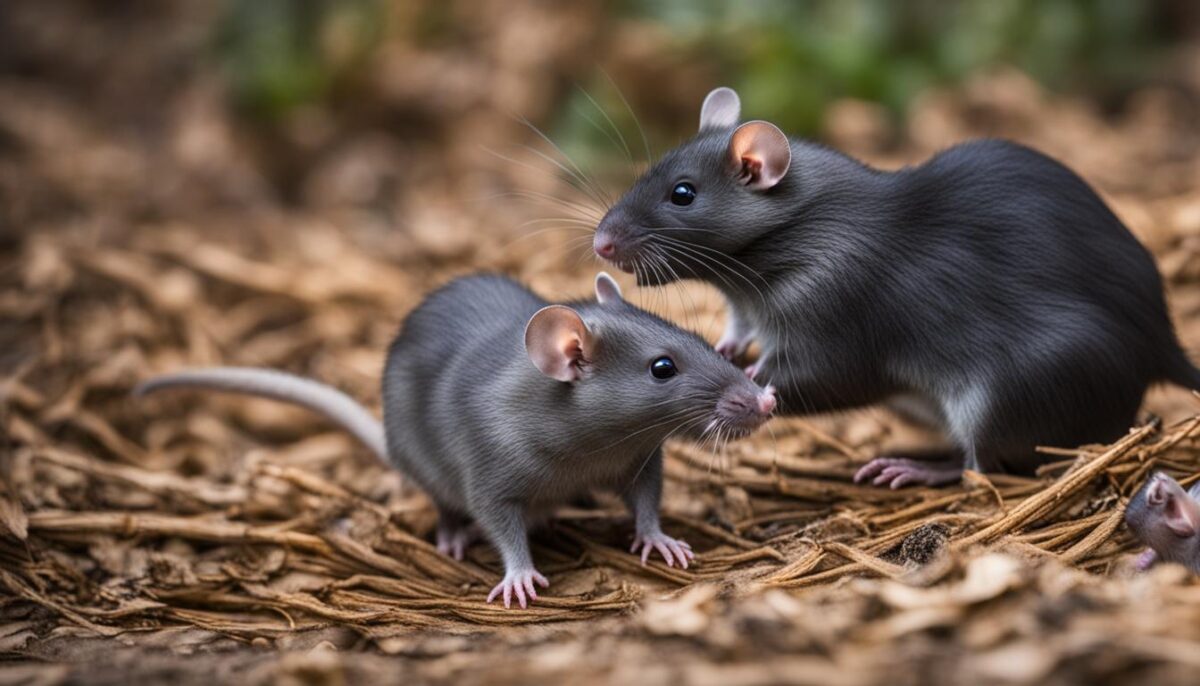
Dealing with Rat Aggression
If you find that your rats are displaying sudden aggression, it is important to take appropriate steps to address the issue. Neutering male rats can be an effective solution to alleviate aggression and establish a more harmonious dynamic. This procedure should be performed under the guidance of a veterinarian and requires a recovery period of 6-8 weeks. Neutering can help reduce testosterone levels, which often contribute to dominance-related aggression in male rats.
For female rats, it is crucial to identify and eliminate the underlying cause of aggression. This may involve addressing competition for resources, such as food or territory. Gradual reintroduction and supervised playtimes may be necessary after a period of separation to ensure a smooth transition. It is always recommended to seek advice from a veterinarian or an experienced rat behaviorist to develop a tailored plan for managing aggression in female rats.
In addition to addressing the aggression itself, creating a safe environment for your rats can also help prevent future conflicts. Providing a spacious and clean cage with separate levels or sections can minimize territorial disputes. Rat-proofing the surrounding area and offering enrichment activities, such as toys, tunnels, and climbing structures, can keep rats mentally stimulated and prevent boredom, which may contribute to aggression.
| Neutering Male Rats | Addressing Aggression in Female Rats |
|---|---|
| – Neutering can help reduce testosterone levels, alleviating dominance-related aggression. | – Identify and eliminate the underlying cause of aggression, such as competition for resources. |
| – Undergo the procedure under the guidance of a veterinarian. | – Gradual reintroduction and supervised playtimes may be necessary. |
| – Recovery period of 6-8 weeks is required. | – Seek advice from a veterinarian or experienced rat behaviorist. |
By implementing these strategies, you can effectively manage and reduce rat aggression, creating a more peaceful and harmonious living environment for your furry companions.
Creating a Safe Environment for Rats
Providing a safe environment for your pet rats is essential to prevent sudden aggression and promote their overall well-being. Follow these tips to ensure your rats are comfortable and happy:
1. Spacious and Clean Cage
Choose a cage that provides enough space for your rats to move around comfortably. A larger cage with multiple levels or sections can help prevent territorial disputes among rats. Regularly clean the cage to minimize odor and maintain a hygienic environment for your pets.
2. Rat-Proof Surroundings
Rat-proof the area where your rats roam outside of their cage to prevent potential hazards. Secure any electrical wires, remove toxic plants or substances, and seal off any small openings or gaps where rats could escape or get stuck.
3. Enrichment Activities
Keep your rats mentally stimulated by providing plenty of enrichment activities. Include toys, tunnels, climbing structures, and bedding materials in their cage to encourage exploration and play. Rotating toys regularly can also prevent boredom.
4. Healthy Diet
Feed your rats a balanced diet that includes a mix of high-quality rat pellets, fresh fruits and vegetables, and occasional treats. This will ensure they receive the necessary nutrients to support their physical and mental health.
5. Proper Socialization
Rats are social animals and thrive on companionship. Provide opportunities for your rats to interact with you and each other through supervised playtimes and gentle handling. This will help strengthen their bond and prevent feelings of loneliness or aggression.
By creating a safe and enriching environment for your rats, you can minimize sudden behavior changes and aggression. Remember to observe your rats closely and seek professional advice if you have any concerns about their well-being.
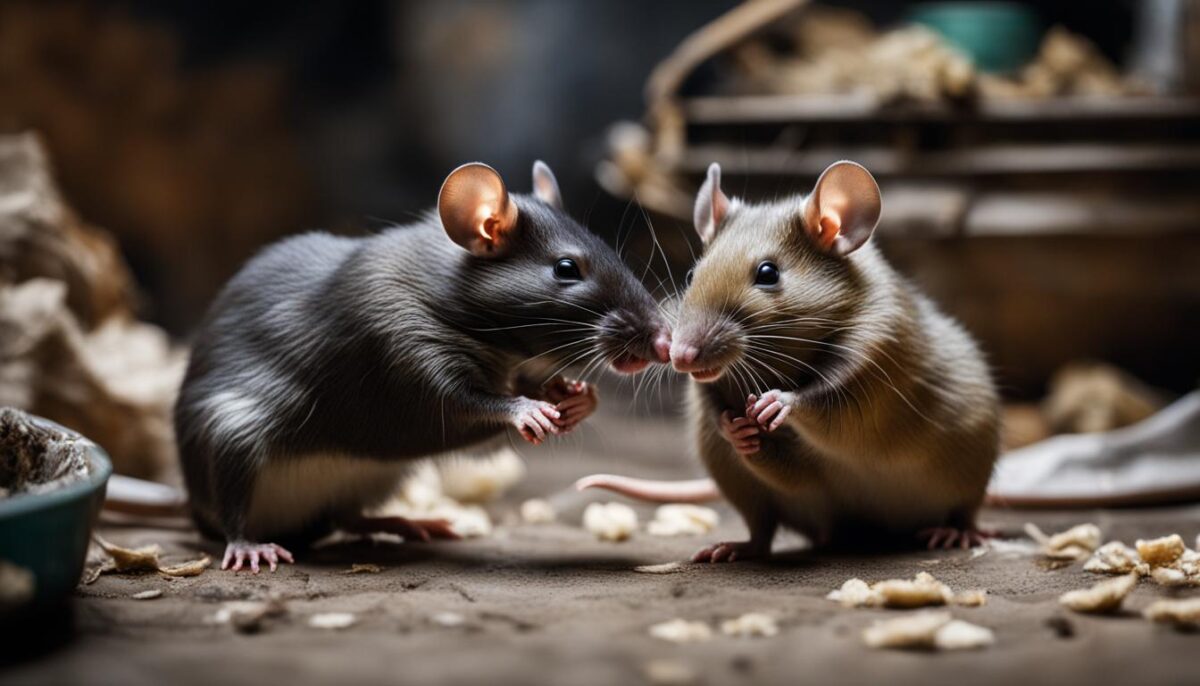
Understanding Rat Behaviors: Nesting and Investigating
Rats exhibit various behaviors that reflect their natural instincts. Two such behaviors are nesting and investigating. Understanding these behaviors can help pet parents provide a suitable environment for their rats and ensure their well-being.
Nesting: Nesting is a common behavior among rats. It involves the creation of a soft and safe spot for resting and birthing pups. Rats gather materials like fleece bedding, paper towels, and cardboard to line their nests. Creating a comfortable nest is essential for rats to feel secure and reduce stress.
Investigating: Rats are highly curious animals and exhibit investigating behavior. They rely on their sense of smell, touch, and sensitive whiskers to explore new items and determine their safety. Investigating behavior is a way for rats to gather information about their environment and satisfy their innate curiosity.
By observing and understanding these behaviors, pet parents can provide suitable nesting materials and enrich their rat’s environment with safe objects for investigating, promoting their natural instincts and overall well-being.
| Nesting Behavior | Investigating Behavior |
|---|---|
| Rats gather materials like fleece bedding, paper towels, and cardboard to create a soft and safe spot for resting and birthing pups. | Rats rely on their sense of smell, touch, and sensitive whiskers to explore new items and determine their safety. |
| Creating a comfortable nest is essential for rats to feel secure and reduce stress. | Investigating behavior helps rats gather information about their environment and satisfy their innate curiosity. |
| Rats exhibit nesting behavior when they are preparing to give birth or simply seeking a cozy place to rest. | Investigating behavior is a way for rats to explore their surroundings and interact with new objects. |
Rat Grooming and Barbering: Understanding Behavior and Potential Issues
Rats are naturally clean animals and engage in grooming behaviors as part of their daily routine. Grooming involves rubbing their paws on their face and licking their bodies, helping to keep their fur free of dirt and maintaining overall hygiene. It is also a social behavior, as rats may groom each other or their pet parents as a sign of affection and bonding.
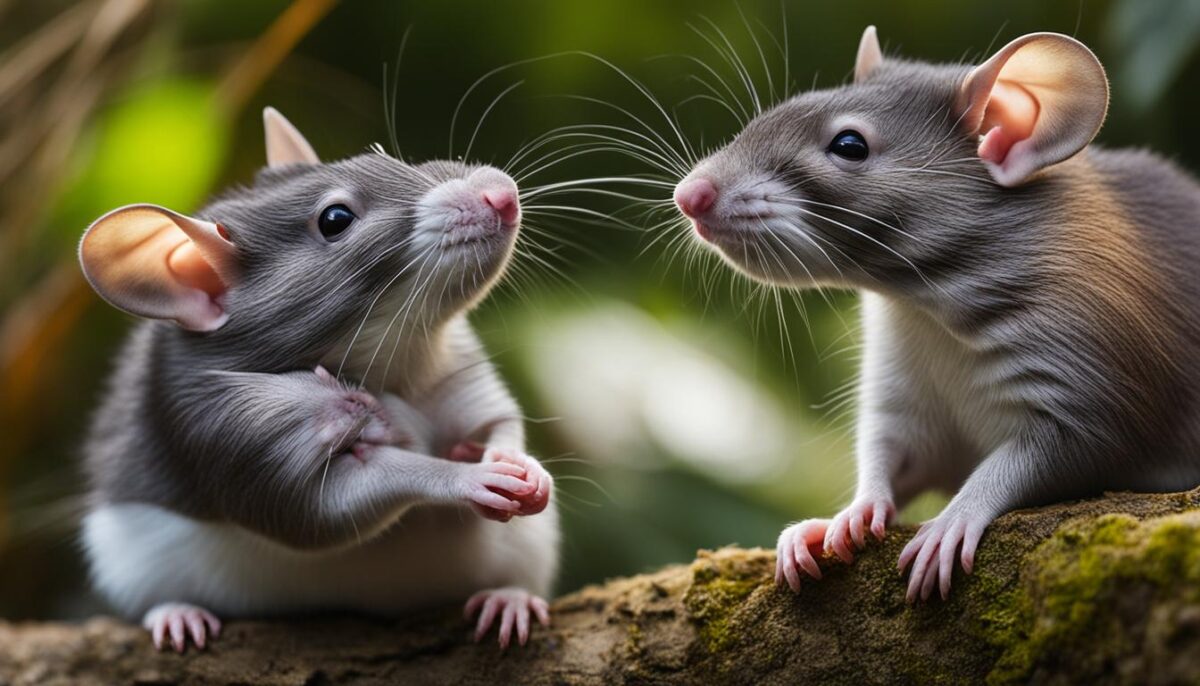
However, excessive grooming or barbering can indicate underlying health problems or dominance issues among rats. Self-barbering occurs when rats excessively groom or chew on themselves or other rats, leading to bald patches or skin irritation. This behavior can be a response to stress or boredom, or it may be a sign of mites, skin infections, or genetic disorders.
It is important for pet parents to observe their rats closely and seek veterinary advice if excessive grooming or barbering is noticed. A veterinarian can help determine the cause of the behavior and provide appropriate treatment or interventions. Regular veterinary care, a clean and enriching environment, and a balanced diet can also contribute to overall rat well-being and minimize the occurrence of grooming-related issues.
Common Causes of Excessive Grooming and Barbering in Rats
Excessive grooming and barbering in rats can have various underlying causes. It is essential to identify and address these causes to prevent further complications and improve the rats’ quality of life. Some common causes include:
- Stress or boredom: Rats may engage in excessive grooming as a coping mechanism for stress or due to lack of mental stimulation.
- Mites or other parasites: Infestation of mites or other parasites can cause itchiness and discomfort, leading to excessive grooming.
- Skin infections: Skin infections, such as fungal or bacterial infections, can trigger excessive grooming behavior.
- Dominance issues: Dominant rats may display barbering behavior, chewing on the fur of submissive cage mates.
- Genetic factors: Some rats may have a genetic predisposition to excessive grooming or barbering behavior.
By addressing the underlying causes and providing appropriate care, pet parents can help their rats lead happier, healthier lives.
| Signs of Excessive Grooming and Barbering | Possible Causes |
|---|---|
| Bald patches or thinning fur | Mites, skin infections, stress |
| Skin redness or irritation | Allergies, fungal or bacterial infections |
| Overly aggressive grooming of cage mates | Dominance issues |
“Excessive grooming or barbering in rats can be a sign of underlying health problems or dominance issues.”
It is important to address excessive grooming or barbering behaviors promptly to prevent the development of more severe issues, such as skin infections or open wounds. Consulting with a veterinarian experienced in rat care can help determine the cause of the behavior and provide appropriate treatment options. By addressing the underlying causes and promoting a stimulating and stress-free environment, pet parents can help their rats maintain optimal grooming habits and overall well-being.
Bruxing and Boggling in Rats
Rats exhibit various behaviors that provide insights into their well-being and emotions. Bruxing and boggling are two fascinating behaviors that rat owners often observe. Bruxing refers to the rhythmic grinding of the teeth, while boggling involves the movement of the eyes in and out of the sockets during intense bruxing. Let’s take a closer look at these behaviors and what they indicate about your furry friend’s state of mind.
Bruxing Behavior
Bruxing is a common behavior among rats and is considered a sign of contentment and relaxation. As rats’ incisors constantly grow, bruxing helps wear them down and keeps them in good condition. When a rat is bruxing, you may hear a soft grinding sound. It’s a delightful display of their happiness and comfort.
Boggling Behavior
Boggling is a fascinating behavior that accompanies intense bruxing. It involves the rat’s eyes twitching or bulging in and out of their sockets. This behavior is completely normal and usually indicates the rat’s high level of pleasure or excitement. It’s like a rat’s way of showing the world how ecstatic they are. Boggling is often seen in rats when they are receiving attention, being petted, or enjoying a favorite treat.
Rat owners should note that bruxing and boggling can also occur when rats are stressed or in pain. If you notice these behaviors accompanied by other signs of distress or discomfort, it’s important to consult with a veterinarian to ensure your rat’s well-being.
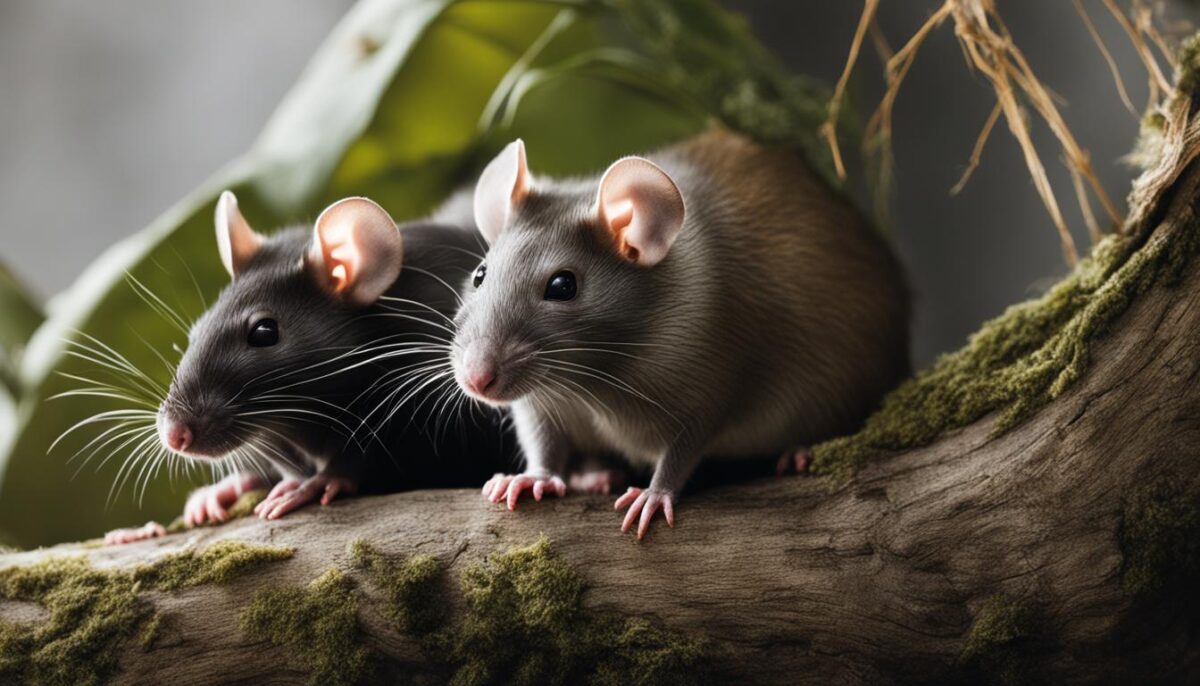
Table: Bruxing and Boggling Behavior
| Behavior | Meaning |
|---|---|
| Bruxing | Contentment and relaxation |
| Boggling | Intense pleasure or excitement |
| Accompanying signs of distress | Seek veterinary advice |
Rat Chattering and Playing Behavior: Understanding Their Meanings
When it comes to rat behavior, chattering and playing are two distinct behaviors that can be easily misinterpreted. It’s important to understand the difference between these behaviors to provide appropriate care and address any concerns.
The act of chattering in rats is a form of aggressive teeth grinding that typically occurs during moments of internal struggle or annoyance. It often serves as a warning sign of potential fights between rats. On the other hand, playing is a joyful behavior characterized by chirps, vocalizations, and other noises. Rats may engage in play fighting, which helps them form bonds and learn social cues.
“Chattering is a clear indication of tension or frustration in rats. It’s their way of expressing their discomfort or unease,” explains Dr. Victoria Smith, a veterinary behaviorist. “On the other hand, when rats are playing, they exhibit high-pitched vocalizations and engage in friendly physical interactions, such as chasing and tumbling.”
It’s crucial for rat owners to differentiate between play fighting and serious aggression. Play fighting is a normal part of rat socialization and helps them develop important skills. However, if the play becomes overly aggressive or leads to real fights, it’s important to intervene and separate the rats to prevent injuries.
| Key Differences Between Chattering and Playing Behavior in Rats | Chattering Behavior | Playing Behavior |
|---|---|---|
| Meaning | Sign of internal struggle or annoyance | Expression of joy and social interaction |
| Characteristics | Teeth grinding, tense body language | Chirps, high-pitched vocalizations, physical interactions |
| Context | May precede or indicate potential fights | Occurs during friendly play sessions |
| Response | Intervention may be needed to prevent aggression | Monitor and ensure play remains friendly |
Rats are intelligent and social animals, and understanding their behaviors is essential for their well-being. By recognizing the signs of chattering and play, rat owners can provide a suitable environment that promotes positive interactions and ensures the happiness of their furry companions.
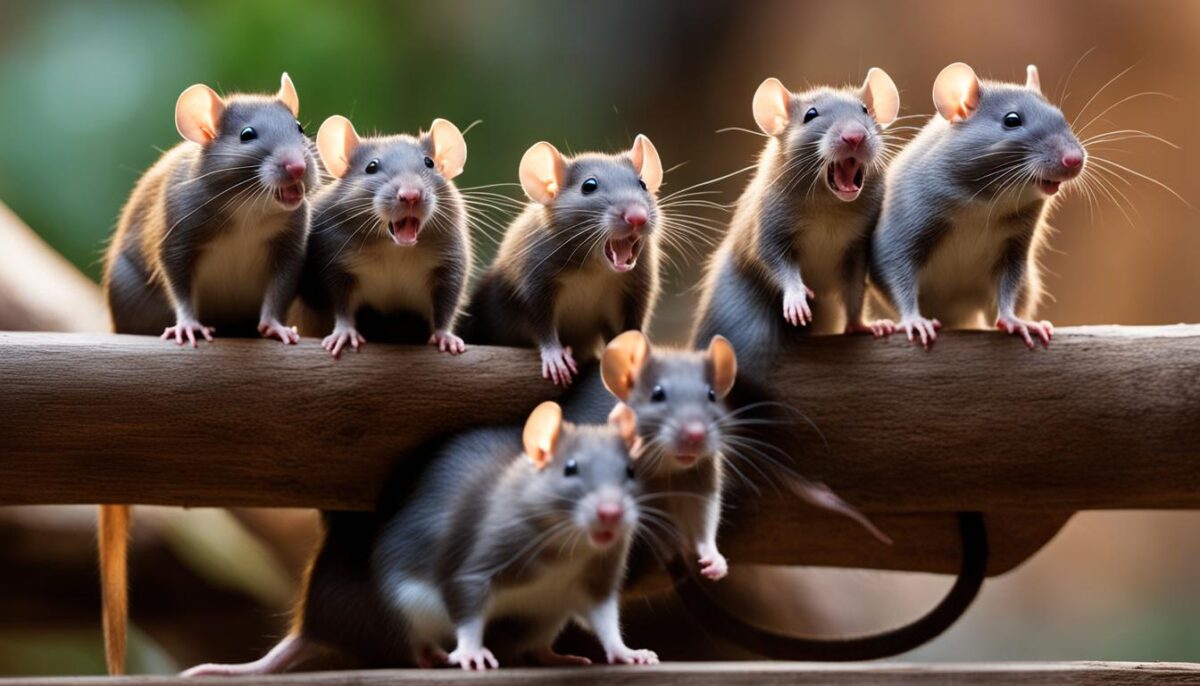
Conclusion
Understanding rat behavior is essential for ensuring the well-being of these furry companions and preventing unnecessary conflicts. By being able to differentiate between playing, dominance behavior, and serious fighting, pet parents can take appropriate actions when necessary to maintain a harmonious environment.
For male rats exhibiting sudden aggression, neutering can often help reduce aggressive tendencies and establish a more amicable dynamic. Female rats, on the other hand, may require identifying and addressing the underlying causes of aggression, such as competition for resources, to resolve the issue.
In addition to addressing aggression, creating a safe environment for rats is crucial. Providing adequate cage space, regular cleaning, and rat-proofing the surroundings can minimize stress triggers and potential conflicts. Enrichment activities like toys, tunnels, and climbing structures can also keep rats mentally stimulated and prevent boredom-induced aggression.
Regular veterinary care is vital to monitor rat behavior changes and address any health concerns that may contribute to sudden aggression. By closely observing rat behavior and seeking professional advice when necessary, pet parents can ensure the well-being of their rats and foster a peaceful and happy living environment.
FAQ
Why are my rats fighting all of a sudden?
There can be various reasons for sudden rat fights, including changes in hierarchy, resource competition, or underlying health issues.
How can I recognize dominance behavior in rats?
Dominance behavior in rats includes pinning another rat onto their back and power grooming. It is a natural part of social interaction, but can escalate into serious fighting if not managed properly.
What are the signs of serious fighting in rats?
Serious fighting in rats can be identified by puffed-up fur, rats standing on their hind legs facing each other, sidling up with hind leg kicks, and hissing.
Why is it important to differentiate play from fight behavior in rats?
Distinguishing between play and fight behavior helps understand their social dynamics and determine if intervention is necessary to prevent injuries.
How can I deal with rat aggression?
Immediate separation is necessary if rats are engaging in serious fighting. Neutering male rats can often resolve dominance-related aggression, while identifying and addressing the underlying cause is important for female rats.
How can I create a safe environment for rats?
Providing a spacious and clean cage, rat-proofing the surrounding area, and offering enrichment activities can help prevent aggression and promote their well-being.
What are the behaviors of nesting and investigating in rats?
Nesting is when rats create a soft spot for resting and birthing pups, while investigating involves their curious nature and reliance on sniffing, touching, and exploring with their whiskers.
What is the significance of grooming and barbering in rats?
Rats groom themselves regularly, but excessive grooming or barbering can indicate health problems or dominance issues that may require veterinary attention.
What are bruxing and boggling in rats?
Bruxing is teeth grinding associated with contentment and affection, while boggling refers to the movement of the eyes during intense bruxing. Both behaviors are typically normal but can also occur when rats are stressed.
What are chattering and playing behaviors in rats?
Chattering is aggressive teeth grinding often associated with potential fights, while playing involves joyful behaviors like chirping, vocalizations, and play fighting that help rats form bonds and learn social cues.
What should I do if I observe sudden rat aggression?
Remember to monitor rat behavior closely and seek professional advice from a veterinarian if any concerns arise about sudden rat aggression or behavior changes.


